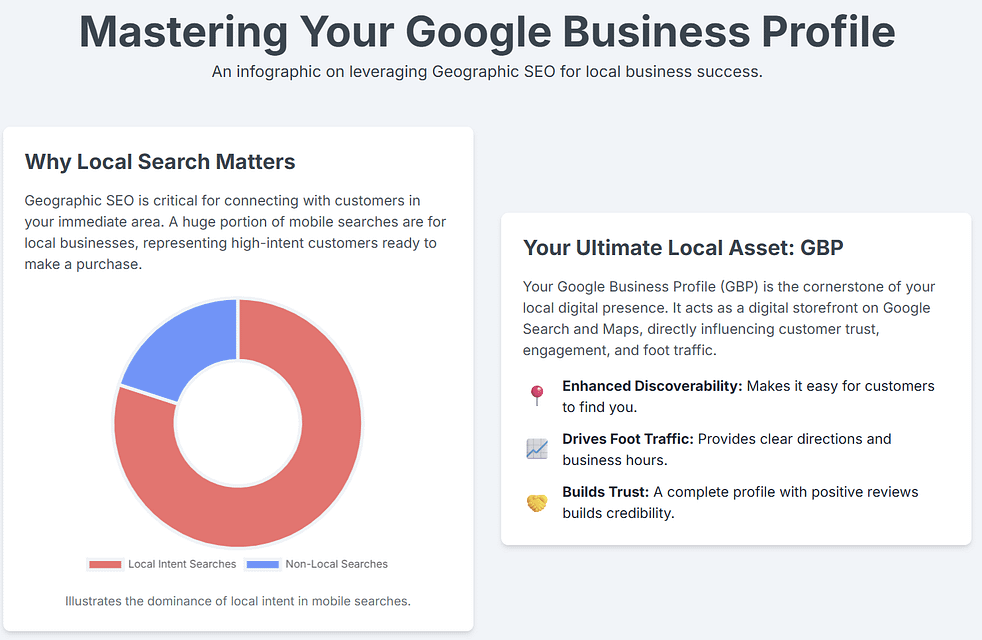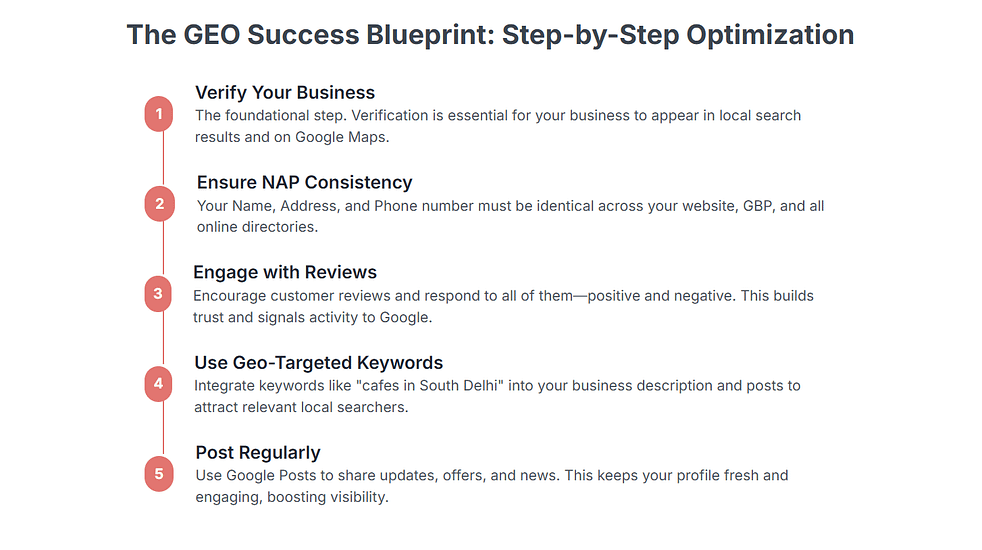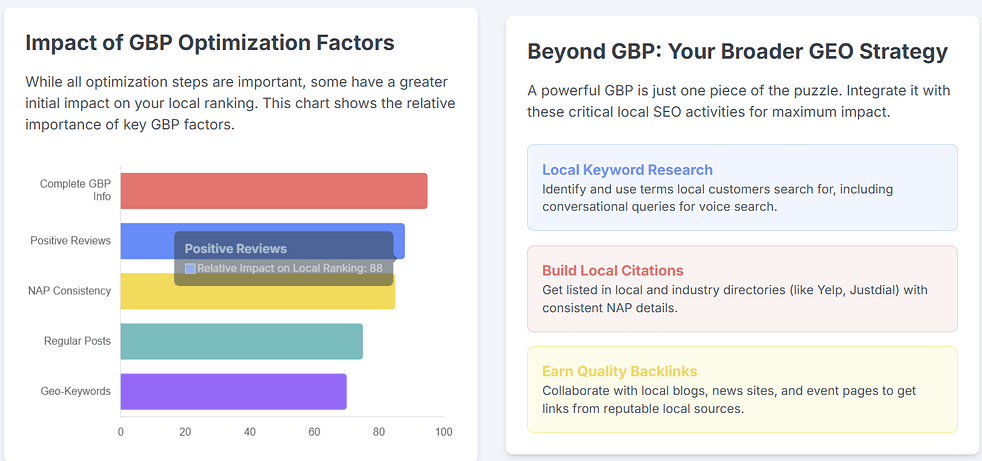In the contemporary digital landscape, the ability for a business to appear prominently in local search results is no longer merely advantageous; it is an imperative for both survival and sustained growth. Consumers are increasingly relying on “near me” searches via their smartphones to locate products and services, making a robust local online presence absolutely critical. At the heart of this local digital strategy lies the Google Business Profile (GBP), serving as a crucial digital storefront that bridges businesses with potential customers in their immediate vicinity.
For the purposes of this discussion, “GEO Success” specifically refers to Geographic SEO, often known as geo-targeting or local SEO. This specialized discipline focuses on optimizing a business’s online visibility for location-specific search queries. While the broader concept of “Generative Engine Optimization (GEO)” involves leveraging artificial intelligence for content generation, the emphasis here remains firmly on the strategic application of Geographic SEO to enhance local discoverability. This report will detail actionable strategies and provide crucial insights for businesses to leverage their Google Business Profile, thereby achieving enhanced local visibility and fostering significant growth.
Understanding the Power of Geographic SEO
Geographic SEO is a specialized form of search engine optimization designed to help local businesses achieve greater visibility in search engine results. Its core function is to connect businesses with potential customers who are located in specific geographic areas, ensuring that clients in a business’s immediate vicinity can effortlessly locate its offerings.1 This strategic approach plays a pivotal role in augmenting a business’s online presence and, crucially, in increasing physical foot traffic to its establishment.1
The indispensable nature of Geographic SEO stems from several key factors:
- Connecting with Local Customers: It directly links businesses with nearby customers who exhibit high intent to purchase or engage with services.1 This direct connection is vital for converting local interest into tangible business.
- Increased Visibility: Effective Geographic SEO ensures that businesses appear prominently in local search results and on Google Maps, which are often the first points of contact for local consumers.1
- Competitive Advantage: A meticulously executed geo-targeting strategy can provide a significant edge, enabling businesses to surpass competitors within their specific local markets.1
- Relevance in Diverse Markets: In markets characterized by vast and mixed demographics, such as India, Geographic SEO is particularly potent. It allows businesses to precisely target potential customers across different locations, effectively addressing the varying tastes and distinct needs of diverse local populations.1 This means that Geographic SEO is not merely a generic strategy but rather a vital tool for market adaptation and localization. It enables hyper-localization, allowing for tailored content and targeting that leads to increased relevance and engagement within specific locales, ultimately conferring a competitive advantage in fragmented markets.
GEO targeting, in this context, is the strategic application of digital marketing efforts to reach specific audiences based on their geographic location. This ensures that the content and advertisements presented are highly relevant and appealing to the target audience within those defined areas.1 The objective extends beyond mere visibility; it is about reaching the right people who are prepared to convert. When Geographic SEO successfully enhances visibility, it reaches high-intent local searchers, leading to a higher likelihood of engagement through clicks, calls, or requests for directions. This direct path to increased foot traffic and conversions represents a clear trajectory toward business growth and a tangible return on investment.

Your Google Business Profile: The Ultimate Local SEO Asset
A meticulously maintained Google Business Profile (GBP) stands as the cornerstone of a robust local online presence.1 It functions as a business’s primary digital representation on Google Search and Maps, offering essential information at a glance to potential customers. The profile serves as a virtual storefront, providing immediate access to critical details such as business hours, contact information, and directions, making it an indispensable tool for local discoverability.
The direct impact of GBP on visibility and engagement is profound:
- Enhanced Discoverability: A well-optimized GBP significantly simplifies the process for potential customers to find a business when they search for local products or services.1 This immediate accessibility is crucial in a market driven by quick, localized searches.
- Driving Foot Traffic: The GBP directly contributes to an increase in physical visits to an establishment by providing clear directions and highlighting key business hours.1 This direct link between online presence and offline visits underscores its practical value.
- Building Trust: A complete and accurate profile, particularly one adorned with positive customer reviews, plays a vital role in building credibility and fostering trust with potential customers.1 This goes beyond mere visibility; it speaks to the psychological impact on potential customers. A complete and verified GBP projects a professional image, signaling legitimacy to both users and search engines. Positive reviews further reinforce this credibility, leading to increased user trust and a higher likelihood of engagement and conversion.
- Direct Communication Channel: The GBP facilitates easy communication, allowing customers to get in touch with the business directly, thereby strengthening its market position.1 It functions as a micro-conversion hub, enabling immediate actions such as calls, website clicks, or direction requests directly from the search results page, streamlining the customer journey and accelerating the conversion path.
Step-by-Step Guide to Optimizing Your Google Business Profile for GEO Success
Optimizing a Google Business Profile is a systematic process that significantly enhances local search visibility. Each step is crucial for establishing a strong digital presence and attracting local customers.
1. Business Verification: The Foundational Step
The initial and most critical step is to ensure that a business’s location is verified and accurately represented on Google.1 This verification process is fundamental for the business to appear prominently in local search results and is essential for building trust with potential customers. Without verification, Google cannot confidently display the business information, severely limiting its local reach.
2. NAP Consistency: Your Uniform Digital Identity
Maintaining consistent business Name, Address, and Phone number (NAP details) across all online platforms is paramount.1 This consistency must extend beyond the Google Business Profile to include Google Maps, the business’s website, and all other online directories such as Justdial and Sulekha.1 The importance of this consistency cannot be overstated; it prevents confusion for users and ensures that search engines accurately display business information, thereby reinforcing its legitimacy.1 Inconsistency in NAP details is a major local SEO impediment. When search engines, like Google, encounter conflicting information, their ability to verify a business’s identity is hampered, leading to lower confidence in the business’s information and a reduced ranking potential in local search results. This directly translates to decreased visibility and lost potential customers, underscoring that consistency is a prerequisite for local SEO success.
3. Engaging with Reviews: Building Trust and Feedback
Actively encouraging customers to leave reviews for a business is vital.1 Equally important is the practice of responding to all reviews, whether positive or negative.1 This demonstrates that the business values customer feedback and is actively engaged with its audience. Reviews on business directories serve as powerful signals of relevance and trustworthiness to both potential customers and search engines, significantly influencing potential customers and improving local search ranking.1 Reviews are dynamic SEO signals. Positive reviews coupled with active responses signal customer satisfaction and business engagement to search engines, leading Google to perceive the business as reputable and active. This boosts local ranking factors and attracts more users who rely on peer recommendations, creating a virtuous cycle of visibility and trust.
4. Strategic Keyword Integration: Speak Your Audience’s Language
Incorporating geo-targeted keywords into the Google Business Profile description is a strategic move.1 This practice helps the profile appear in relevant local searches. For instance, a café in Delhi might use keywords like “cafes in South Delhi,” or a dental practice in Jaipur might use “dentists in Jaipur” to attract local patrons.1 This ensures that the business’s profile is discoverable by individuals actively searching for specific services within their geographic area.
5. Compelling Descriptions & Regular Google Posts: Keep it Dynamic
Crafting a clear and engaging description for the business profile makes it more appealing to users.1 Furthermore, regularly utilizing Google Posts to share updates, offers, events, or news is highly recommended. This practice helps the business maintain relevance and visibility in local searches, ensuring the profile remains dynamic and informative.1 Consistent updates signal to Google that the business is active and provides fresh information, which can positively impact its local ranking.
6. Google Maps Optimization: Pinpointing Your Presence
Correctly setting the business location on Google Maps with a clear and accurate pin is essential.1 This precise placement significantly enhances visibility and can lead to a substantial improvement in local rankings on Google, making it easier for individuals to find the physical location of the business.1 An accurate map listing is often the final step in a customer’s journey from online search to physical visit.

Integrating GBP with Your Broader Geographic SEO Strategy
While the Google Business Profile is undeniably central to local SEO, its full potential is realized when integrated within a broader Geographic SEO ecosystem.
Beyond GBP: The Role of Location-Based Keyword Research
Keyword research forms a foundational component of Geographic SEO. Its objective is to identify the specific terms and phrases that individuals use when searching for products or services at a precise location.1 This targeted approach ensures that a business connects effectively with its intended local audience.
Effective techniques for location-based keyword research include:
- Building Location-Specific Keyword Lists: Developing comprehensive lists of keywords that incorporate geographic modifiers, such as “dentists in Jaipur” or “bakery in Austin,” helps a business stand out and forge stronger connections with local searchers.1
- Analyzing User Behavior: Utilizing tools like Semrush allows businesses to analyze which terms hold the most relevance for users within their specific geographic area.1 This data-driven approach refines keyword selection.
- Natural Keyword Integration: Incorporating these identified keywords naturally into website content and other online assets ensures that they enhance search engine performance without appearing forced or unnatural.1
- Considering Conversational Queries: As voice search gains prominence, it is crucial to consider how people speak when searching. Including longer, conversational keywords like “best restaurant near me” can optimize for these types of queries.1
Building Local Citations and Earning Quality Backlinks
Citations and backlinks are critical for bolstering local SEO rankings.
- Citations: It is imperative to ensure that NAP details remain consistent across all online listings, including prominent directories like Yelp, Foursquare, Justdial, and Sulekha.1 Consistent citations significantly enhance local SEO rankings.1
- Backlinks: Collaborating with regional websites, local event pages, or community blogs to secure quality backlinks is highly beneficial. Such links from reputable local sources bolster a business’s authority and visibility within its geographic market.1
- Engagement: Actively responding to reviews within these directories not only demonstrates excellent customer service but also signals to search engines that the business is engaged and reputable.1
The synergistic effect of an optimized GBP combined with broader local SEO efforts is profound. An accurate and well-maintained GBP, consistent NAP information across various directories (citations), relevant local keyword integration, and quality local backlinks collectively send a powerful, holistic signal to search engines. This amplified visibility and authority lead to a stronger competitive position and increased organic traffic. Furthermore, the emphasis on building authority through Indian business directories and securing backlinks from local sources highlights that local SEO extends beyond technical setup; it involves establishing a robust reputation and network within the local digital ecosystem. Consistent citations signal legitimacy and presence, while local backlinks demonstrate relevance and authority, leading search engines to prioritize businesses with strong local standing, ultimately improving local rankings and fostering trust.

Measuring Your GEO Success: Essential Tools and Metrics
Tracking performance is indispensable for the continuous improvement of any Geographic SEO strategy. Monitoring key performance indicators (KPIs) provides valuable insights into what is working and where adjustments are needed.
Key Performance Indicators (KPIs) for Local SEO Success
- Keyword Rankings: This metric assesses how well a business ranks for its targeted location-specific keywords.1 Improved rankings indicate successful keyword optimization.
- Google Maps Visibility: This measures how easily a business can be found and interacted with on Google Maps, including searches for directions or calls directly from the map listing.1
- User Analytics: This encompasses organic traffic to the business’s website and detailed user behavior metrics, such as time spent on site and bounce rate.1 These analytics provide a deeper understanding of user engagement.
- Foot Traffic: Perhaps the most tangible KPI, this measures the increase in physical visits to the business location, serving as a direct outcome of effective local SEO efforts.1 The inclusion of foot traffic as a key metric explicitly links online SEO efforts to tangible, real-world business outcomes. This emphasizes that SEO is not merely about rankings but about driving actual customers and generating direct revenue.
- Customer Engagement: This includes tracking the volume and quality of reviews, overall ratings, and interactions on the Google Business Profile and other business directories.1
Essential Tools for Tracking Local SEO Performance
To effectively monitor these KPIs, several specialized tools are recommended:
Tool Name | Features |
Semrush Local | Checks geo-based keyword rankings and local search visibility.1 |
Google Analytics | Shows organic traffic and user behavior on your site.1 |
Google Search Console | Provides details about how your pages perform in local search results.1 |
Yelp Insights | Looks at customer engagement and reviews.1 |
These tools empower businesses to gain valuable insights into their local search performance, identify areas for improvement, and ultimately drive more people to their physical locations. The process of measurement is not a one-off check but an integral part of a continuous improvement loop. By implementing a Geographic SEO strategy, measuring its performance with these tools, analyzing the data to identify strengths and weaknesses, refining and adjusting the strategy based on those insights, and then re-implementing and re-measuring, businesses can achieve continuous optimization for sustained local SEO success.

Navigating Challenges and Maximizing Benefits in Diverse Markets
Implementing Geographic SEO, particularly in diverse markets, presents both unique challenges and significant opportunities.
Common Challenges in Geographic SEO
- Data Consistency: A persistent challenge involves ensuring that NAP details are correct and uniformly presented across all online platforms.1 Discrepancies can confuse search engines and users alike.
- Maintaining Relevance: Staying current with rapidly evolving local trends and the specific needs of customers in a mixed market can be demanding.1
- Competitive Landscape: Standing out amidst a multitude of local businesses, many of whom are also vying for local search visibility, requires sustained effort and strategic differentiation.1
Solutions to Overcome Hurdles
- Rigorous NAP Management: Regularly auditing and meticulously correcting NAP details on Google Maps and all relevant business directories is crucial for maintaining data accuracy and consistency.1
- Expert Collaboration: For complex markets, collaborating with SEO experts can significantly improve citations and keyword rankings, leveraging specialized knowledge to navigate intricate local algorithms.1
- Continuous Optimization: Maintaining an active presence through regular Google Posts, prompt responses to reviews, and consistent content updates ensures ongoing relevance and visibility.
Unique Benefits of a Strong GEO Strategy
Despite the challenges, a robust Geographic SEO strategy offers distinct advantages, particularly in diverse markets:
- Hyper-Local Targeting: It grants the ability to connect with individuals in highly specific geographic areas, allowing businesses to address their unique tastes and needs with tailored offerings.1 While market diversity can make it difficult for local businesses to shine, Geographic SEO transforms this challenge into an opportunity for highly specialized and effective targeting. This precision reduces competition within niche geographical areas, leading to higher conversion rates due to hyper-relevance.
- Enhanced Local Engagement: Increased relevance directly translates to better engagement and higher rankings for “near me” searches, capturing the attention of high-intent local consumers.1
- Stronger Competitive Edge: By optimizing for multiple geographic areas, a business builds resilience against competitors, establishing a more entrenched position within various local markets.1
- Increased Relevance and Visibility: As more people come online, investing in Geographic SEO becomes critical for local businesses to maintain their presence and remain discoverable.1 This underscores the long-term value of “relevance” over mere “reach”; in a diverse market, simply reaching a large audience is insufficient. Geographic SEO focuses on attracting a highly relevant local audience, leading to higher engagement and conversion rates, fostering sustainable growth through loyal local customers, and ensuring long-term market relevance and resilience.
Conclusion: Your Path to Local Digital Dominance
Geographic SEO, with the Google Business Profile at its core, represents a critical and indispensable strategy for any business aspiring to thrive in today’s dynamic digital landscape. By strategically focusing an online presence on local populations, businesses can significantly enhance their visibility and attract the most relevant customers.
The journey to local digital dominance involves understanding the importance of location-based keyword research, ensuring consistent NAP details across all platforms, actively engaging with customer reviews, and diligently utilizing essential tracking tools. Every component of this process is crucial for optimizing SEO performance and improving search engine visibility. While implementing these strategies, it is important to proactively address any challenges that may arise. The ultimate objective extends beyond merely achieving higher rankings; it is about forging authentic connections with the local community and delivering tangible value to customers. For businesses seeking to further amplify their growth, particularly in complex or highly competitive markets, enlisting the expertise of SEO professionals can significantly enhance the potential of their Geographic SEO and Google Business Profile efforts.1
Frequently Asked Questions (FAQs)
How does Geographic SEO differ from traditional SEO?
Geographic SEO is specifically tailored to help businesses appear in local search results by leveraging location-specific keywords and citations to target nearby customers. In contrast, traditional SEO focuses on achieving higher search engine rankings for a broader, global audience, without being tied to a specific physical location. While both aim to increase online visibility, Geographic SEO’s distinct focus on particular areas enables more targeted engagement with local populations.1
Can small businesses in India benefit from Geographic SEO?
Absolutely. Small businesses can significantly enhance their visibility within specific locations, attract a greater number of potential customers, and notably boost foot traffic to their physical establishments. By implementing effective location-based strategies, such as maintaining an updated Google Business Profile and listing their business in local directories, small businesses can establish a robust online presence. This ensures that even amidst challenging market conditions, people can easily discover their business, making it an excellent method for new customers to find them in their target areas.1
What are the best ways to measure Geographic SEO success?
Success in Geographic SEO is typically measured through several key indicators: improved keyword rankings for local terms, increased visibility on Google Maps, enhanced user analytics (including organic website traffic and user behavior patterns), and a measurable increase in physical foot traffic to the business location. Tools such as Google Analytics, Semrush Local, Google Search Console, and Yelp Insights provide valuable data and insights to continuously monitor and refine local search performance.1
How long does it take to see results from Geographic SEO?
Typically, businesses begin to observe noticeable results from their Geographic SEO efforts within approximately 3 to 6 months. The speed at which results materialize can be influenced by various factors, including the quality of citations, the strength of backlinks, and the overall robustness of the content. Consistent updates and ongoing optimization efforts are crucial for sustained improvements in rankings and organic traffic within the local area over time.1




